|
93. Vanessa atalanta (Linnaeus, 1758) / Red admiral / Nymphalidae – Nymphalinae
NL: atalanta, nummervlinder, admiraalvlinder / D: Admiral / F: vulcain, l’admiral
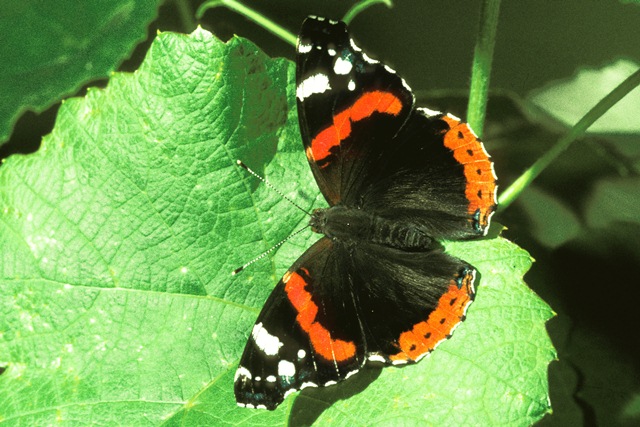  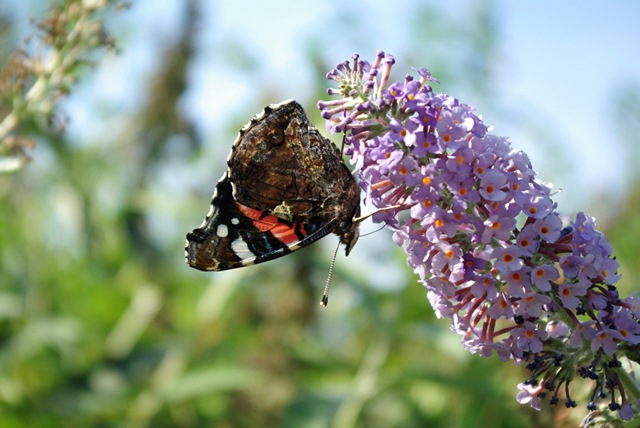 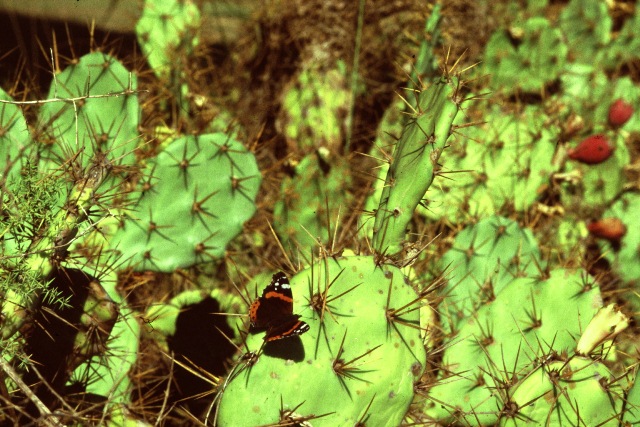
Photographs: Frits Bink ©.
Large, wing length 29 (26-32) mm. In the Benelux everywhere in the countryside in summertime, in gardens, edges of woods and copses.
Butterfly is on the wing from April to November, however in different flight periods: in Wallonia it peaks early to mid-July, in Flanders and Netherlands in mid-September. This may be the result of the return flight from Scandinavia passing the coastal region.
The species is known from different regions in Europe, in wintertime from the Mediterranean area and in summertime from the temperate climate area. In wintertime it occurs in maritime and subcontinental climate, amplitude 4 to 10, in summertime also in continental climate, amplitude up to 17. Required heat sum for the summer brood is 600°d and the maximum tolerated 1300°d, corresponding climate windows 22 and 30 weeks. In the Mediterranean the required heat sum is between 1500°d and 3300°d and the average temperature of the coldest month is not below 7°C.
This butterfly is the strongest migrant of the European continent, comparable with the famous American monarch butterfly, Danaus plexippus. V. atalanta occurs also in North-America and on the Macaronesian Islands.
The pupae that hatch late in season in the temperate climate zone produces butterflies which have little chance to complete the autumn return flight and are forced to look for a hibernating place. Sometimes butterflies are seen early in the spring and it is assumed that they have successfully overwintered in a frost free place.
Ecological characteristics
Behaviour over time
Overwintering: adult in Mediterranean region, in the temperate region sometimes also successful overwintering in a cave or stable. In the temperate region where the winters are very mild such as in Brittany or southwest England the sighting of butterflies early in spring is not a rare phenomenon.
Reproduction: oviposition starts in spring and in summer the offspring may start with oviposition after 6-8- days. A repeated egg production may occur, the butterfly alternates periods of foraging with oviposition. A full loaded body may contain about 100 eggs and repeating of egg production may happen 5-8 times.
Larval feeding periods: three weeks in summer period from May until September.
Generations: varies with summer warmth, one to three.
Spreading of risk: the long life span and high reproduction and migratory behaviour ensures that the species easily survives unpredictable setbacks.
Life cycle: egg 5 (4-6) days; larva 23 (18-29) days; pupa 12 (9-15) days.
Life span of adult: 6-9 weeks after start of reproduction period in summer, 34-40 weeks in overwintering generation.
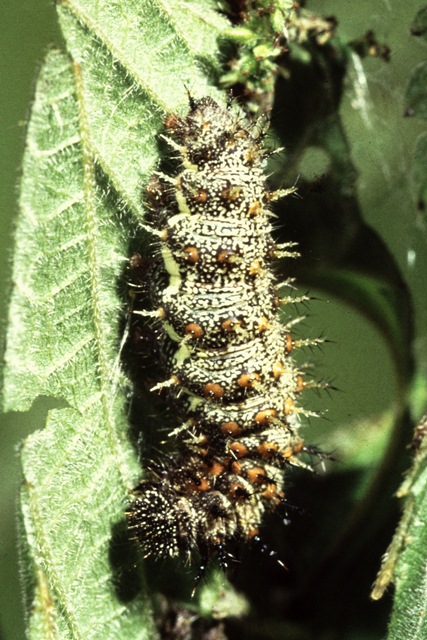
Photographs: Frits Bink ©.
Behaviour in space
From stay-at-home to migrant: migrant, spatial requirement very great.
Finding a mate: intermitted perch and patrol.
Orientation in the landscape: edges of woods and copses.
Oviposition: individually on the upper side of a leaf.
Defence
Threats from other organisms: larvae is armoured with spines and lives hidden in a tube of a folded leaf. Rearing experiments showed that larvae are often attacked by braconid wasps Cotesia spp.
Threats from the environment: both larvae as well as adult are vulnerable from heat and cold, the adult butterfly will die when temperature falls below -4°C.
Feeding habits
Adult: nectar of all kind of flowers, sap of wounded trees, rotten fruit.
Larva: lives hidden in a folded leaf and may bite partially through the leafstalk that causes a light wilting of the leaf.
Larval foodplants
Plant species: Urticaceae, Urtica dioica, U. urens, in the Mediterranean Parietaria officinalis, Urtica membranous, U. pilulifera, U. dubia.
Journal
Rearing experiment based on specimen from Blankenheim, Germany:
21 June 1983: eggs collected.
24 June: eggs hatched.
10 July: larvae nearly fully grown.
13 July: pupated.
21 July: hatched.
Table 93-1. Results of dissections

Table 93-2. Collection and observation localities
Winter:
GR, Rhodos, 36° 12’N - 28° 04’E; 13 April 1990 (larvae and adults).
E, Sierra de Espuña, 622 m, 37° 53’ 14”N – 1° 29’ 44”W; 13 February 2005 (adults only).
P, Quarteira, 37° 04’48”N – 8° 08’ 46”W; 10 November 1985, 21 November 1985 (adults only).
Summer:
B, Torgny, 237 m, 49° 30’ 40”- 5° 29’ 04”E; 19 June 1983.
D, Blankenheim, 50° 22’ 40”N – 6° 41’ 05”E; 20 June 1983.
D, Borkener Paradies, 52° 43’ 29”N – 7° 14’ 36”E; 9 July 2002.
D, Kaiserstuhl, Badberg, 433 m, 48° 05’ 47”N – 7° 40’ 40”E; 9 July 1985.
F, Brittany, Telgruc-sur- Mer, 48° 12’ 25”N – 4° 22’ 25”W, 29 September 2004.
F, Cap Blanc-Nez, 30 m, 50° 55’ 37”N – 1° 42’45”E; 10 June 2000.
F, la Grande Brière, 47° 23’ 42”N – 2° 17’ 22”W; 24 September 2004.
F, Lorraine, Jaulny, 209 m, 48° 57’ 55”N – 5° 52’ 52”E; 8 July 2006.
F, Lorraine, Rupt devant Saint-Mihiel, 280 m, 48° 53’ 01”N – 5° 24’ 10”E; 28 June 2006.
F, Montmédy, 217 m, 49° 31’ 07”N – 5° 21’ 33” E; 18 August 1984.
F, Normandy, Havre de Surville, 49° 16’ 47”N – 1° 40’ 23”W; 19 September 2005.
NL, Amerongen, garden 52° 00’ 01”N – 5° 27’ 34”E; 1975-1986.
NL, Bennekom, garden 51° 59’ 30”N – 5° 40’ 34”E; 1988-2014.
NL, Leersum, garden 52° 00’ 29”N – 5° 24’ 04”E; 1975-1986.
NL, Rottemeroog, 53° 32’ 30”N – 6° 34’ 32”E; 9 September 2000.
S, Gotland, Hummelbosholm, 57° 11’ 48”N – 18° 32’ 56”E; 8 July 2004.
Fig. 93-1. Vanessa atalanta, phenogram adapted from Bos et al. 2006: 225 (darker part) & Fichefet et al. 2008: 255 (lighter part).
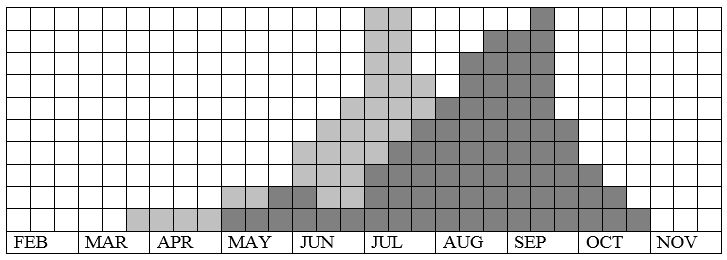
Fig. 93-2. Vanessa atalanta, habitat characteristics.
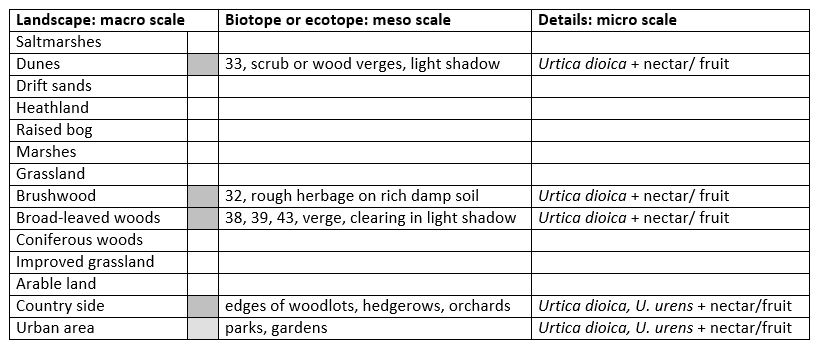
Fig. 93-3. Vanessa atalanta, climate matrix. Unsuitable climate (the clearest grey part).
Heat-sums: suitable in summer season 600-1300°d (dark part), suitable in winter season 1500-3300°d (jan +7ºC, lighter part).
.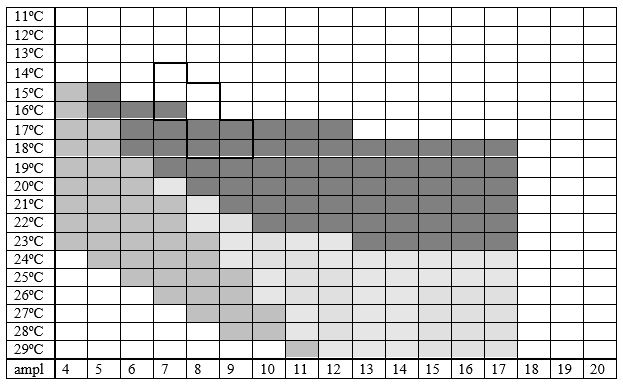
|










